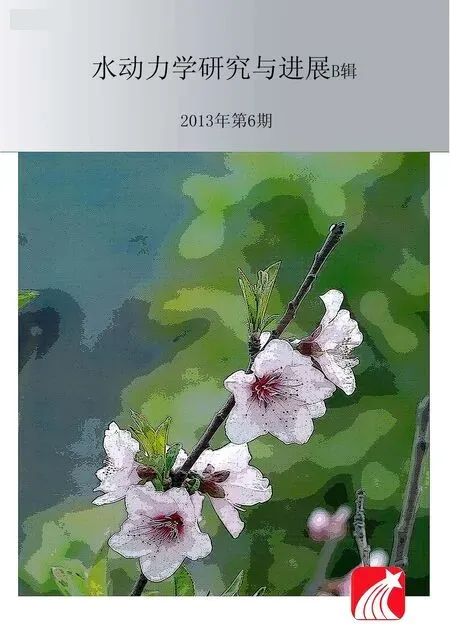The influence of low-permeability cap on capillary pressure during pumping in unconfined aquifer*
HUANG Hui (黄辉), QIAN Jia-zhong (钱家忠)
School of Resources and Environmental Engineering, Hefei University of Technology, Hefei 230009, China, E-mail: huanghuifengye@163.com
KUANG Xing-xing (匡星星)
Department of Earth Sciences, The University of Hong Kong, Hong Kong, China
CHEN Bing-yu (陈冰宇), MA Lei (马雷), WU Ya-nan (吴亚楠)
School of Resources and Environmental Engineering, Hefei University of Technology, Hefei 230009, China
The influence of low-permeability cap on capillary pressure during pumping in unconfined aquifer*
HUANG Hui (黄辉), QIAN Jia-zhong (钱家忠)
School of Resources and Environmental Engineering, Hefei University of Technology, Hefei 230009, China, E-mail: huanghuifengye@163.com
KUANG Xing-xing (匡星星)
Department of Earth Sciences, The University of Hong Kong, Hong Kong, China
CHEN Bing-yu (陈冰宇), MA Lei (马雷), WU Ya-nan (吴亚楠)
School of Resources and Environmental Engineering, Hefei University of Technology, Hefei 230009, China
(Received October 26, 2012, Revised March 10, 2013)
The pumping test in an unconfined aquifer with and without a low-permeability soil was studied experimentally to reveal the influence of the negative air pressure (NP) caused by the upper layer on the water content (w), the water pressure (Pw), as well as on the capillary pressure (Pc). The study demonstrates that the NP generated in the vadose zone during pumping in the capper aquifer has a significant influence onw,PwandPc. ThePcobtained from the capped aquifer is smaller than that without the upper layer. After the NP reaches a peak, the influence of the NP onPcis gradually declined as the air inflows through the upper layer which makes the NP gradually return to zero. When the air pressure returns to the atmospheric pressure,Pcin the vadose zone is only correlated withPw, the same as the case with no upper layer.
low-permeability soil, water content, water pressure, capillary pressure, vadose zone, pumping test
Introduction
The capillary pressure is commonly present in unsaturated zones and the mechanism of the capillary pressure was studied for a long time[1-3]. The term capillarity initially refers to the action of liquids in fine tubes, but has since come to be used in connection with a wide variety of phenomena, including under certain conditions the flow of liquids through porous media[4-8]. At the same time, the air or air-water flows and their interaction in unsaturated zones were studied widely mainly in the fields of the infiltration and the contaminant transport[9,10]. Despite the long time study of the capillary pressure, the interaction between the air flow and the capillary pressure in the vadose zone is not well understood. In particular, when the air in an aquifer does not flow through the unsaturated zone, the influence on the pumping test cannot be ignored, and when the hydraulic head is higher than the bottom of the low-permeability soil, the capillary pressure must be considered[11]. Some numerical simulations and experiments were carried out to study the change of the air pressure in the vadose zone with a low-permeability layer[11-15], but there were no specific experiments to explore the interaction between the air pressure and the capillary pressure. The objective of this paper is to investigate the change of the capillary pressure with time during the pumping test in an unconfined aquifer with a low-permeability layer in the unsaturated zone. This study will provide new insights into the change of the capillary pressure in the vadose zone during pumping tests.
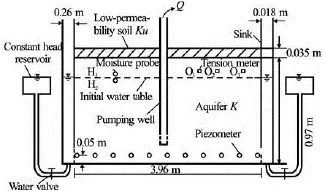
Fig.1 Schematic diagram of the experimental setup for pumping test with low-permeability cap
1. Experimental setup and methods
1.1Experimental setup
Figure 1 is a schematic diagram of the experimental setup, which is modified from that of Huang et al.[11]. The physical system is a two-layered sand box with a thin fine layer on the top. The sand box is put in a Plexiglas trough of 3.96 m in length and 0.76 m in width. The thickness of the lower layer is 0.97 m and the thickness of the upper fine layer is 0.035 m. The lower layer material is the homogeneous medium sand with the following grain size distribution: the sand with diameter greater than 0.002 m: 1.27%, the sand with diameter between 0.001 m and 0.002 m: 2.03%, the sand with diameter between 0.0005 m and 0.001 m: 88.28%, and the sand with diameter less than 0.00025 m: 6.16%. There is a water tank on each side of the sand box to supply water to the aquifer system during pumping. The left water tank is 0.26 m in length and 0.76 m in width and the right water tank is 0.18 m in length and 0.76 m in width. In addition, two small constant head water reservoirs are designed and connected to the water tanks to supply water to the water tank. A partially penetrating well with an inner diameter of 0.04 m is located in the lower part of the aquifer. The screen length is 0.2 m and the bottom of the screen is 0.2 m above the impermeable bottom. Three tension meters are installed on one side of the pumping well to measure the water pressure and the distances from the well are 0.37 m, 0.99 m, 1.52 m (in order to facilitate the discussion below, the locations of the tension meters are denoted as O1, O2, O3), respectively. Two moisture probes are installed, one is located between the upper layer and the aquifer to measure the change of the water content in the vadose zone (H1) and the other is located near the initial water table (H2). Eleven piezometers to measure the hydraulic head during pumping are installed 0.05 m above the bottom of the aquifer and the heads measured at the two piezometers near the boundaries are used in the boundary condition. The hydraulic conductivity of the aquifer ()Kis 6.16×10-4m/s. The upper layer material is the homogeneous silt with a low hydraulic conductivity of 5.31×10-7m/s, and the system is considered as air-confined.
1.2Experimental method
The experimental model can be regarded as an air-confined system with a partially penetrating well as the permeability of the upper layer is much smaller than that of the aquifer. The hydraulic gradient of the aquifer is controlled by adjusting the water level difference between the inflow and outflow reservoirs (Fig.1). The initial conditions used in this paper are similar to that in Huang et al.[11].
During the experiments, the water content (w) and the water pressure (Pw) are measured for both cases with and without the upper layer. The pumping rates are controlled by a peristaltic pump with error less than 0.5%. The hydraulic heads are measured with eleven piezometers with error less than 0.0005 m. The water contents are measured with two moisture probes with error less than 0.5%. The average atmospheric pressure is about 101 kPa.

Fig.2 NP-time curve near the point O1
2. Experimental results and discussions
In order to investigate the effects of the negative air pressure (NP) in the unsaturated zone on the capillary pressure, comparisons are made between experimental results with and without the NP (or the upper layer) because the NP in our study is only generated in the capped aquifer. Figure 2 shows how the NP at the observation point near O1changes with time in the capped aquifer and the corresponding pumping rate ()Qis about 35ml/s, a condition which will be kept the same in the following discussions. The changes of the NP are in keeping with the results in Jiao et al.[15]and Huang et al.[11]. The NP is mainly generated at the earlier stage of pumping, it increases from zero to a peak, and then gradually returns to the atmospheric pressure as the air flows from the atmosphere into the aquifer. To analyze the influence of the upper layer on the capillary pressure in the vadose zone, two otherparameters are to be considered: the water content (w) and the water pressure (Pw).

Fig.3 Changes of water content with time at point H1
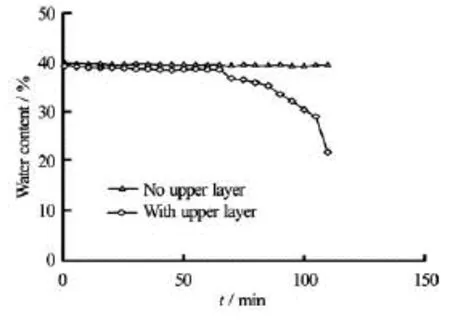
Fig.4 Changes of water content with time at point H2
2.1The impact of the upper layer on the water contentFigure 3 shows the temporal changes of the water content in the vadose zone with and without the upper layer. It can be seen that at the earlier stage of pumping there is a substantial amount of water in the vadose zone in the case with the upper layer. As pumping time progresses, the water content gradually decreases. Clearly, the existence of the upper layer greatly restricts the movement of water in the unsaturated zone. The water content in the case with the upper layer is significantly greater than that in the case without the upper layer during most of the pumping time. However, the differences gradually decrease at the later stage of pumping when the NP is almost becomes zero. This is due to the fact that the water in the vadose zone is sucked by the NP and could not drain freely. Consequently, the decrease of the water content in the vadose zone in the capped aquifer is slower than that in the aquifer without the upper. Figure 4 shows the changes of the water content with time at the initial water table. It can be seen that the water content in the case with the upper layer decreases faster than that in the case without the upper layer, which is opposite to what is shown in Fig.3. This is because a great amount of water in the vadose zone is sucked by the NP, then the water in the saturated zone must be drained faster than that in the case without the upper layer.
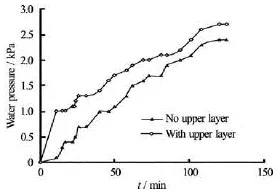
Fig.5 Changes of water pressure with time at point O1
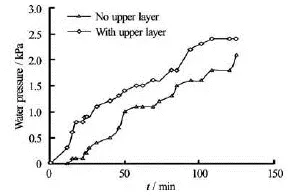
Fig.6 Changes of water pressure with time at point O2
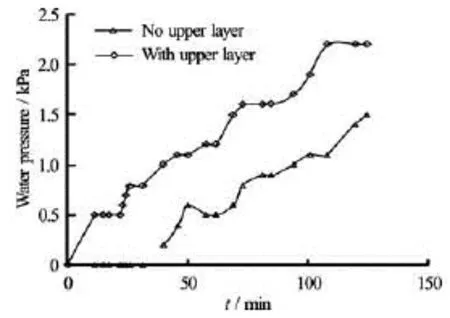
Fig.7 Changes of water pressure with time at point O3
2.2The impact of the upper layer on the water pressure with time
Figures 5-7 show the changes of the water pressure with time with and without the upper layer in the vadose zone at different radial distances (O1, O2, O3). It can be seen that during the pumping, the water pressure is gradually increases with time in both cases with and without the upper layer, but the water pressure in the case with the upper layer is larger than that in the case without the upper layer. The reason is that a great amount of water is sucked by the NP in the vadose zone and the water in the vadose zone could not drain freely. Then the drawdown in the aquifer with the upper layer is larger than that in theaquifer without the upper layer. As a result, a larger water pressure is induced in the vadose zone in the capped aquifer.
2.3The impact of upper layer on capillary pressure
The above discussion shows that the NP will have an impact onwandwPin the unsaturated zone. The impact can also be significant on the capillary pressure (Pc), becausePcis related to the water pressure (Pw) and the gas pressure (Pg). The relationship among them can be denoted as follows:Ps=Pc=Pg-Pw, wherePsis the soil suction in the unsaturated zone,Pgis the gas pressure in the unsaturated zone, andPwis the water pressure. From the relationship we can see thatPs=Pc=-PwwhenPg=0. During the pumping in a capped aquifer, the NP (gP, negative) will be generated andwP(negative) will be increased as discussed previously, hence the absolute value ofcPwill decrease. However, as the pumping goes on, the NP gradually returns to zero and the influence of the NP onw,wPwill gradually decrease. When the NP returns to the atmospheric pressure,cPin the vadose zone will be only correlated withwP, which is the same as the case without the upper layer.
3. Conclusion
In this paper, series of pumping tests in an unconfined aquifer with and without a low-permeability soil were carried out to investigate the influence of the NP caused by the upper layer onwandwPas well as oncP. The experiment results reveal that the pumping in the capped aquifer produces an NP in the vadose zone, which in turn influencesw,wP, andcP. During the pumping, the water in the vadose zone is sucked by the generated NP and could not drain freely. Hence, more water is drained in the saturated zone and the drawdown is larger than that in the aquifer without the upper layer. As a result, the water pressure in the vadose zone is larger than that in the aquifer without the upper layer. At this moment, the influence of the NP oncPis significant and thecPobtained from the capped aquifer is smaller than that obtained from the aquifer without the upper layer. After the NP reaches the peak value, the influence of the NP oncPis gradually weakened as the air inflow through the upper layer which makes the NP gradually return to zero. However, thecPobtained from the capped aquifer is still greater than that in the aquifer without the upper layer. When the NP returns to the atmospheric pressure, thecPin the vadose zone is only correlated withwP, which is the same as the case without the upper layer.
[1] HOTEIT H., FIROOZABADI A. Numerical modeling of two-phase flow in heterogeneous permeable media with different capillarity pressures[J].Advances in Water Resources,2008, 31(1): 56-73.
[2] GILLHAM R. W. The capillary fringe and its effect on water-table response[J].Journal of Hydrology,1984, 67(1-4): 307-324.
[3] GUO Qiang, CHENG Rui and SILBER-LI Zhan-hua. Influence of capillarity on nano-liter flowrate measurement with displacemet method[J].Journal of Hydrodynamics,Ser. B,2007, 19(5): 594-600.
[4] MARCHAND A., DAS S. and SNOEIJER J. H. et al. Capillary pressure and contact line force on a soft soild[J].Physical Review Letters,2012, 108(9): 094301.
[5] MOENCH A. F. Analytical and numerical analyses of an unconfined aquifer test considering unsaturated zone characteristics[J].Water Resources Research,2008, 44(6): W06409.
[6] CUI Y. J., TANG A. M. and MANTHO A. T. et al. Monitoring field soil suction using a miniature tensiometer[J].Geotechnical Testing Journal,2008, 31(1): 95-100.
[7] DROR I., BERKOWITZ B. and GORELICK S. M. Effects of air injection on flow through porous media: Observations andanalyses of laboratory-scale processes[J].Water Resources Research,2004, 40(9): W09203.
[8] HANSPAL N. S., DAS D. B. Dynamic effects on capillary pressure-saturation relationships for two-phase porous flow: Implications of temperature[J].AIChE Journal,2012, 58(6): 1951-1965.
[9] HUSSAIN F., CINAR Y. and BEDRIKOVETSKY P. A Semi-analytical model for two phase immiscible flow in porous media honouring capillary pressure[J].Transport in Porous Media,2012, 92(1): 187-212.
[10] WEERAKONE W. M. S. B., WONG R. C. K. and MEHROTRA A. K. Measurement of capillary pressure curve of DNAPL in a water-saturated sandstone fracture[J].Journal of Geotechnical and Geoenvironmental Engineering,2012, 138(5): 614-624.
[11] HUANG Hui, QIAN Jia-zhong and KUANG Xing-xing et al. Experimental study of airflow induced by pumping tests in unconfined aquifer with low-permeability cap[J].Journal of Hydrodynamics,2012, 24(4): 605-608.
[12] LI H. L., JIAO J. J. One-dimensional airflow in unsaturated zone induced by periodic water table fluctuation[J].Water Resources Research,2005, 41(4): W04007.
[13] GUO H. P., JIAO J. J. Numerical study of airflow in the unsaturated zone induced by sea tides[J].Water Resources Research,2008, 44(6): W06402.
[14] KUANG X., JIAO J. J. and WAN L. et al. Air and water flows in a vertical sand column[J].Water Resources Research,2011, 47(4): W04506.
[15] JIAO J. J., GUO H. P. Airflow induced by pumping tests in unconfined aquifer with a low-permeability cap[J].Water Resources Research,2009,45(10): W10445.
10.1016/S1001-6058(13)60434-5
* Project supported by the National Natural Science Foundation of China (Grant No. 41272251), the Research Grants Council of the Hong Kong Special Administrative Region, China (Grant No. HKU 701908P).
Biography: HUANG Hui (1989-), Female, Master
QIAN Jia-Zhong,
E-mail: qjiazhong@gmail.com
- 水动力学研究与进展 B辑的其它文章
- A three-dimensional hydroelasticity theory for ship structures in acoustic field of shallow sea*
- Experimental study of the interaction between the spark-induced cavitation bubble and the air bubble*
- A preliminary study of the turbulence features of the tidal bore in the Qiantang River, China*
- The calculation of mechanical energy loss for incompressible steady pipe flow of homogeneous fluid*
- Experimental study by PIV of swirling flow induced by trapezoid-winglets*
- Analysis of shear rate effects on drag reduction in turbulent channel flow with superhydrophobic wall*

